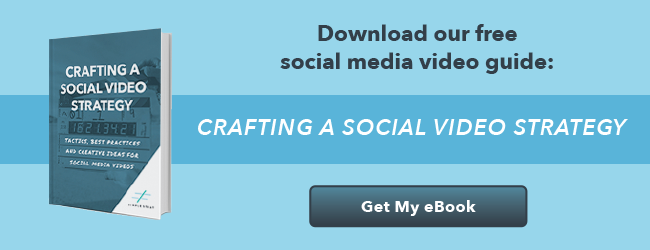How many videos have you watched today?
When you start to really think about the answer to that question, it may surprise you. Whether it’s in our social media feeds, on TV, at work, or on a display at the store, video has permeated much of our daily lives. So much so that we often don’t realize how much video content we actually watch.
People watch over 100 million hours of video per day on Facebook alone. For YouTube, it’s over a billion. Yeah, that’s billion with a “B”. With all the video we’re watching these days, video content is now a necessity in every marketing strategy. Let us be clear: if you’re not using video to market your business, you’re doing it wrong.
But don’t worry, whether you’re looking to create your first video or simply looking for new video marketing ideas, you’ve come to the right place. We’ll run through the eight types of videos your business could incorporate into your marketing efforts. Let’s jump in.
1. Live Video
Purpose: Increase visibility and engagement on social media and create stronger connections with customers and prospects.
Live video scares a lot of people, but it’s one of the easiest forms of video to create. It requires no professional video crews or equipment, no editing, and can be done from just about anywhere.
Live video is also one of the most effective forms of video you can create for your business. It offers the transparency and authenticity that consumers crave. Social media platforms like Facebook also reward live video by notifying your followers and bumping you to the top of their newsfeeds.
Use live video in your social media to inform your customers about your products, interview subject-matter experts, give a behind-the-scenes look into your office or an event, or anything else your team can come up with. All you need is a strong internet connection and a cell phone.
2. Team and Intro Videos
Purpose: Humanize your company.
We all know that people do business with the people they know, like, and trust. A problem with today’s digital communications is that it can be difficult to know, like, or trust a name in an email signature or a small photo on an “about us” web page. But with video, you can go a long way toward bridging that gap.
One way that we do this at Simple Strat is by including introduction videos in our email signatures. This gives people an opportunity to hear our voice, understand our role, and learn an interesting fact or two about us. We also include a welcome video in one of the first emails we send to new customers. This helps them get to know the team that will be working on their marketing, which is especially helpful for non-local clients.
3. How-To & Informational Videos
Purpose: Build trust and credibility by establishing your brand as a thought leader and improve your customer service efficiency and effectiveness.
A good portion of the one billion hours of video watched each day on YouTube is educational content. From car repair to using new software, many people turn to online videos when they want to learn how to do something. If your brand can be the source of the videos that help your prospective customers, you’ll quickly establish yourself as a credible leader in your space.
Use instructional and how-to videos to support your content marketing. If you’re blogging, consider including short videos in a post to help illustrate your points like we did in our recent post, "Behind the Scenes on How to Record a Video on iPhone". You can also simply make a video version of each post that you can use on YouTube, social media, and at the top of the blog post itself. This will help you expand your reach and appeal to people who prefer video over written content, all without having to come up with content ideas beyond what you’re posting in your blog.
To help your current customers and save time for your customer support team, consider also making videos that answer your most commonly asked questions. These, paired with tutorial videos, can be sent in response to customer service requests and included on help or support pages on your website.
Here's a great example from the video example library over at Wistia:
4. Product Demo Videos
Purpose: Demonstrate the features and benefits of your product and create efficiencies in your sales process.
What if you could send your best sales person on a trip to visit all of your prospective customers to show off your products? Well, a good product demo video is the next best thing.
The type of product you sell will dictate how you’ll need to create this video. But, whether you’re selling high-end cars or low-cost software subscriptions, there are four best practices you’ll want to follow:
- Spend some time thinking about what needs to be included in the script. Stay true to your core brand messaging but make sure you’re also talking to your sales people and learning what’s working best for them.
- Try to find a way to incorporate your brand’s personality. This is a great way to stand out from the millions of dry, boring product demo videos out there.
- Pay attention to the production quality of the video(s). People will subconsciously link your video quality to the product quality, so make sure your product demo videos are polished and look professionally made.
- Don’t tell, show. You can tell people all about your product on the phone or on your website, but video is one of the only opportunities you have to actually show people your product’s best features. Don’t miss out on that opportunity.
Check out this demo video from Slack for some inspiration:
5. Video Advertisements
Purpose: Sell your products and services by connecting with, informing, and entertaining your prospective customers.
Though the platforms have changed over the years, video advertisements have been around in one form or another since the early days of movie theaters. Why? Because they work. Nothing can entertain, engage, and create an emotional connection or response quite like a video can.
Video ads can take many different forms, but always keep three things in mind when you’re creating them: your brand, your customers, and your channel. For example, if you have a professional brand with wealthy customers and your ad is going on TV, the video should feel clean and polished. On the other hand, if you’re selling t-shirts to teenagers over social media, you might want a more authentic and edgy video shot by an influencer on their iPhone.
The Super Bowl is always a good place to find great ads. Remember this one from Dodge?
6. Animated Explainer Videos
Purpose: Explain complex concepts and allow people to visualize services and software.
Animated explainer videos can range from low-cost whiteboard videos to expensive custom animations, but they can all be a great way to help your customers visualize the intangible. Use them to explain the process you and your clients will go through to deliver a service, give complicated or boring instructions in a more entertaining and easy to understand way, or create videos for products that haven’t yet been produced.
7. Video Testimonials
Purpose: Demonstrate social proof and build credibility.
Building social proof is one of the most powerful marketing tactics a brand can use. If your potential customers see that other people use and enjoy your products or services, it’s much easier for them to make the decision to buy. They often perceive less risk in the decision and/or feel the desire to be like their peers. This is why rating sites are so popular and why you see so many testimonial quotes on websites.
Testimonial videos take those testimonial quotes to the next level. People are much more likely to trust the credibility of a testimonial when they can see the person saying the words. To take full advantage of this, make sure your testimonial videos look authentic. It’s okay to skimp on production value in these videos because it will make them feel more real and won’t give off the impression that the person on camera is a scripted actor.
Here's one we put together for a client of ours:
8. Culture Videos
Purpose: Recruit the right employees and humanize your brand.
Culture videos are a great way to give a behind-the-scenes look into your company and, you guessed it, its culture. The best way to create these videos is to have a charismatic employee or two press record on their cell phones. Using an agency or too much direction from the leadership team can sometimes result in a culture video that doesn’t actually capture your true company culture. If you want to up the production value, do that through the editing process.
Use these videos primarily for recruiting, but don’t think that your customers and potential customers won’t care. Similar to the team and intro videos, culture videos can build trust and show your customers that they’re buying from real people who care about them. Social media is a great place to share these videos for public viewing.
Here's how the marketing automation pros at HubSpot use video to show their culture:
Conclusion
Now that you’re armed with eight different types of video for business, you’re ready to take your marketing to the next level. Just remember to keep it authentic and save your big production budgets for where it counts most.
Now we want to hear from you in the comments. What types of videos are you using in your marketing?

